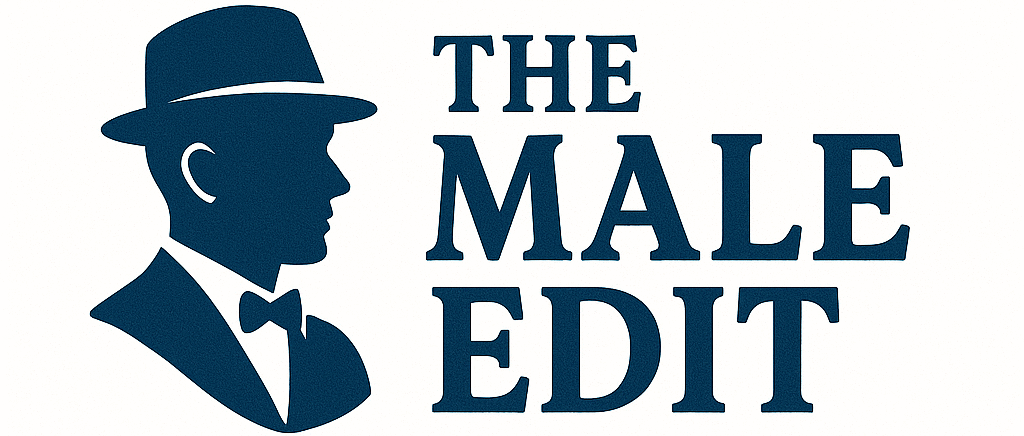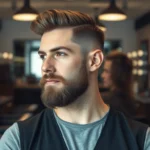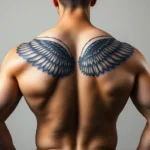Short dreads are revolutionizing men’s hairstyles and we’re here to show you why they’re the perfect choice for modern guys who want style without the commitment. Gone are the days when dreadlocks meant only long flowing locks – today’s short dread styles offer incredible versatility while keeping maintenance simple and professional appearance intact.
We’ve discovered that short dreads work brilliantly for every face shape and lifestyle. Whether you’re a busy professional who needs a polished look or someone who wants to express their creativity these compact styles deliver maximum impact with minimal fuss. They’re easier to maintain than their longer counterparts and dry faster after washing.
The best part? Short dread styles can be achieved in multiple ways and suit various hair textures. From twist-outs to freeform methods we’ll explore the most popular techniques that’ll help you achieve the perfect short dread look that matches your personality and daily routine.
Classic Short Dreads
Classic short dreads represent the foundation of modern dreadlock styling for men who want a timeless look without the commitment of lengthy locks. We find these styles perfect for newcomers to the dread community and experienced wearers seeking a refined appearance.
Traditional Twisted Locks
Twisted locks form the cornerstone of classic short dread styling, using the fundamental twist and rip method that’s been perfected over decades. We recommend starting with hair that’s 2 to 4 inches long for optimal grip and formation. Sectioning your hair into uniform squares creates the most professional appearance, with each section measuring approximately 1 inch by 1 inch.
Professional stylists typically begin by backcombing each section from tip to root, creating the initial texture needed for proper lock formation. We suggest using a metal comb with fine teeth to achieve the tightest backcomb possible. Palm rolling follows immediately after backcombing, where you roll each section between your palms in one direction to encourage the hair to lock together.
Most traditional twisted locks require 3 to 6 months to mature completely, depending on your hair texture and maintenance routine. We’ve observed that coarser hair textures lock faster than fine hair, often showing important progress within the first 8 weeks.
Natural Formation Techniques
Natural formation techniques allow your short dreads to develop organically without excessive manipulation or chemical products. We prefer the neglect method for clients who want the most authentic dread experience, though it requires patience and commitment to the process.
Washing your hair regularly with residue free shampoo encourages natural locking while keeping your scalp healthy. We recommend washing 2 to 3 times per week with sulfate free products that won’t leave buildup in your developing dreads. Sea salt sprays can accelerate the natural locking process by creating texture and removing excess oils that prevent matting.
Sleeping on cotton pillowcases helps create friction that encourages natural knotting, though we suggest switching to silk or satin pillowcases once your dreads mature to prevent frizz. Air drying after washing maintains the natural texture better than blow drying, which can loosen developing knots.
Environmental factors like humidity and wind naturally contribute to the formation process, making outdoor activities beneficial for new dread development. We notice that people living in coastal areas often experience faster natural formation due to salt air exposure.
Maintenance Requirements
Maintenance requirements for classic short dreads are surprisingly minimal compared to longer styles, making them ideal for busy lifestyles. We recommend root maintenance every 4 to 6 weeks to keep your dreads looking neat and prevent new growth from creating a messy appearance.
Palm rolling remains the primary maintenance technique, taking only 15 to 20 minutes to complete on short dreads. We suggest doing light palm rolling weekly on each dread to maintain their shape and encourage continued locking. Root twisting becomes necessary when new growth reaches half an inch, typically occurring every 3 to 4 weeks.
Product usage should remain minimal, with most classic short dreads requiring only a light holding gel or locking cream during maintenance sessions. We avoid heavy oils and conditioners that can soften the hair too much and slow the locking process. Dry shampoo can extend time between washes while maintaining scalp health.
Regular trimming of loose ends keeps classic short dreads looking polished and professional. We recommend professional maintenance appointments every 8 to 12 weeks to address any problem areas and ensure even growth patterns across all dreads.
High Top Fade Dreads
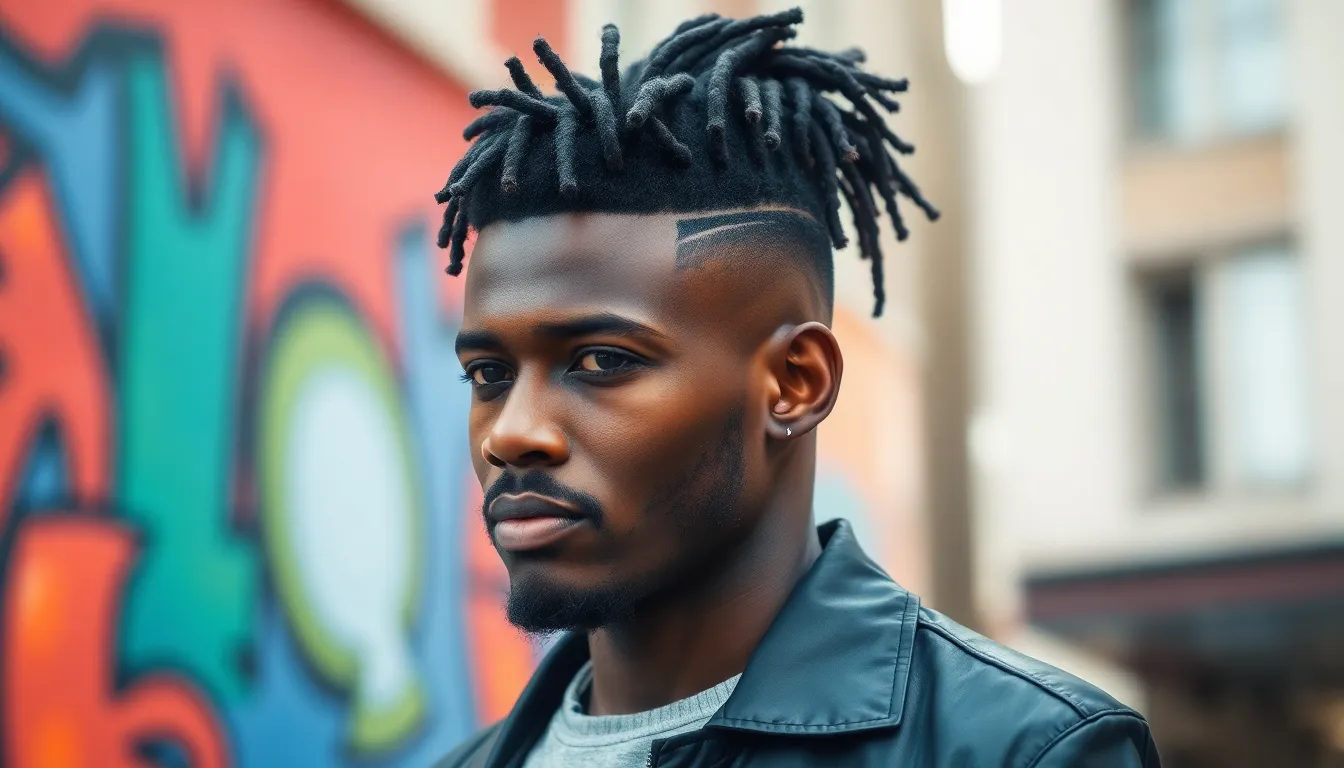
High top fade dreads represent the perfect fusion of classic locs with contemporary barbering techniques. We’ve seen this style gain tremendous popularity for its ability to maintain professional appearance while showcasing individual style.
Surgical Fade Blending
Surgical fade blending creates the sharpest contrast between your dreadlocks and the surrounding hair. We recommend this technique for men who want a well-groomed appearance that commands attention. Barbers achieve this look by precisely tapering the sides and back to create a clean blend from the longer dreads on top to the closely shaved areas below.
Professional execution involves using multiple clipper guard sizes to create seamless transitions. We often see this style enhanced with defined edge-ups and shaved designs in the fade area for added visual interest. The contrast between textured locs and smooth fade creates a striking silhouette that works exceptionally well for both casual and formal settings.
Length Variation Options
Length variations offer endless possibilities for personalizing your high top fade dreads. We’ve identified several popular approaches that work with different hair textures and personal preferences:
Short twisted locs with tight fade work particularly well for men with thinner hair, as the contrast makes locs appear significantly thicker. Short and thick high top dreads feature chunky, bold locs combined with precision fades for maximum impact. Thin high top dreads with fade showcase mid-length locs hanging over tapered sides for a trend-forward appearance.
Styling flexibility allows you to arrange locs hanging forward or backwards depending on your mood. We recommend experimenting with interlocking or twisting techniques to achieve unique textures that complement your facial features. The versatility of this style means you can pull locs back into a top ponytail for formal occasions or leave them loose for casual wear.
Styling Product Recommendations
Product selection plays a crucial role in maintaining both your dreads and fade areas effectively. We recommend lightweight moisturizing sprays or specialized dreadlock conditioners to keep locs hydrated without creating residue buildup that can dull your style.
Light styling gels or creams help define edges and maintain the sharpness of your fade between barbershop visits. Regular application of scalp oils prevents dryness in fade areas, which is particularly important given the frequent trimming required to maintain this look.
When styling locs into ponytails or top knots, we suggest using soft hair bands that won’t create excessive tension and potentially cause breakage. Avoid heavy waxes or thick pastes that can accumulate in short dreads and interfere with the clean lines of your fade. This careful product selection ensures your high top fade dreads maintain their modern, polished appearance for both casual outings and professional environments.
Short Dread Taper Cuts

Short dread taper cuts blend the textured appeal of locs with clean barbering precision. This modern approach creates a sophisticated look that highlights your dreads while maintaining a polished edge.
Gradual Length Transitions
Gradual length transitions create seamless visual flow from your crown to neckline using progressive tapering techniques. We recommend starting with 2 to 4 inch dreads on top while gradually decreasing length toward the sides and back. This blended approach eliminates harsh lines and produces a naturally integrated appearance that looks intentional rather than abrupt.
Professional stylists achieve these transitions by carefully mapping out length zones before cutting. The technique involves maintaining fuller locs at the crown while systematically reducing both thickness and length as the style moves downward. This method allows for customization in dread placement and creates a balanced silhouette that works with your natural head shape.
Professional Styling Tips
Professional maintenance starts with regular retwisting or palm rolling every 4 to 6 weeks to keep locs uniform and healthy. We strongly recommend visiting an experienced stylist for taper fades and undercut designs since these require precise clipper work and steady hands.
Product selection plays a crucial role in maintaining your style’s integrity. Choose lightweight moisturizing sprays over heavy waxes to prevent buildup that can damage both your dreads and fade areas. Light styling gels help define the taper while scalp oils keep your foundation healthy for continued dread growth.
Color enhancement adds personality without overwhelming the natural texture of your locs. Subtle ombré effects or strategic highlights can create visual interest while maintaining a professional appearance. Always consult with a colorist experienced in working with textured hair to avoid damage.
Best Face Shape Matches
| Face Shape | Ideal Taper Style | Key Benefits |
|---|---|---|
| Oval | Any short dread taper | Versatile proportions work with all styles |
| Round | High taper with crown volume | Adds definition and elongates facial features |
| Square | Soft edge tapers | Balances angular jawlines with gentle transitions |
| Heart-shaped | Volume focused styles | Balances narrower chin with fuller crown area |
| Triangular | Mid-length crown tapers | Adds width around temples to even proportions |
Round faces benefit most from tapered sides that create height and definition around the crown area. The vertical emphasis draws attention upward and creates the illusion of length that balances fuller cheeks.
Square face shapes require softer transitional edges to counteract sharp jawlines. We suggest avoiding harsh fade lines that might emphasize angular features and instead opt for gradual blending techniques.
Heart shaped faces need volume concentration in the upper portion to balance narrower chin areas. Strategic loc placement around the temples and crown creates visual weight that harmonizes with your natural bone structure.
Twisted Short Locs

Twisted short locs offer our favorite combination of neat texture and modern versatility for men seeking a fresh take on traditional dreadlocks. We’ve found this style particularly appealing because it creates chunkier, more defined sections by twisting two individual locs together.
Two-Strand Twist Methods
Two-strand twisting serves as the foundational technique for creating and maintaining short locs effectively. We begin by dividing the hair into clean sections and twisting two strands tightly around each other from root to tip. This method works exceptionally well for starting new locs or refreshing existing ones that need structure.
Sectioning becomes crucial when we’re working with shorter hair lengths between 2 to 4 inches. We recommend creating uniform partings to ensure each twist maintains consistent thickness throughout the locking process. The technique also allows us to experiment with loc braids or more complex twisted patterns as the hair grows.
Timing matters significantly when we apply two-strand twisting to short hair. Fresh twists typically hold their shape for 1 to 2 weeks before requiring maintenance, making this method ideal for men who prefer structured styling routines.
Palm Rolling Techniques
Palm rolling keeps short dreadlocks tidy and encourages proper locking formation between maintenance appointments. We perform this technique by rolling each loc back and forth between our palms to smooth frizz and create tighter, more defined sections. The motion helps compress loose hairs into the existing loc structure.
Pressure control becomes essential when we palm roll shorter locs since they’re more delicate than longer, established dreads. We apply gentle, consistent pressure while rolling to avoid breaking the forming locks or creating weak points. The technique works best on slightly damp hair that’s been lightly misted with water.
Direction consistency helps us maintain uniform loc shape during palm rolling sessions. We always roll in the same direction for each individual loc to prevent unraveling and encourage the natural locking pattern to develop properly.
Weekly Care Routines
Weekly maintenance keeps short dreadlocs healthy and maintains their structured appearance throughout the locking process. We wash our locs with residue-free shampoos to prevent product buildup that can interfere with the natural locking progression. Clean hair locks faster and stays healthier than hair weighed down with heavy products.
Post-wash palm rolling becomes our most important weekly ritual for maintaining loc shape and tightness. We perform this technique immediately after washing while the hair is still slightly damp and more pliable. The timing allows us to reshape any locs that may have loosened during the washing process.
Moisturizing requires a light touch when we’re working with short locs that are still forming. We apply minimal amounts of jojoba or coconut oil to the scalp and lightly distribute it through the locs without oversaturating them. Too much moisture can actually slow down the locking process in shorter hair.
Protective styling becomes beneficial between wash days when we want to prevent loose strands from disrupting our loc formation. We use gentle re-twisting techniques or install temporary protective styles that don’t create tension on the developing locs.
Short Dread Undercuts
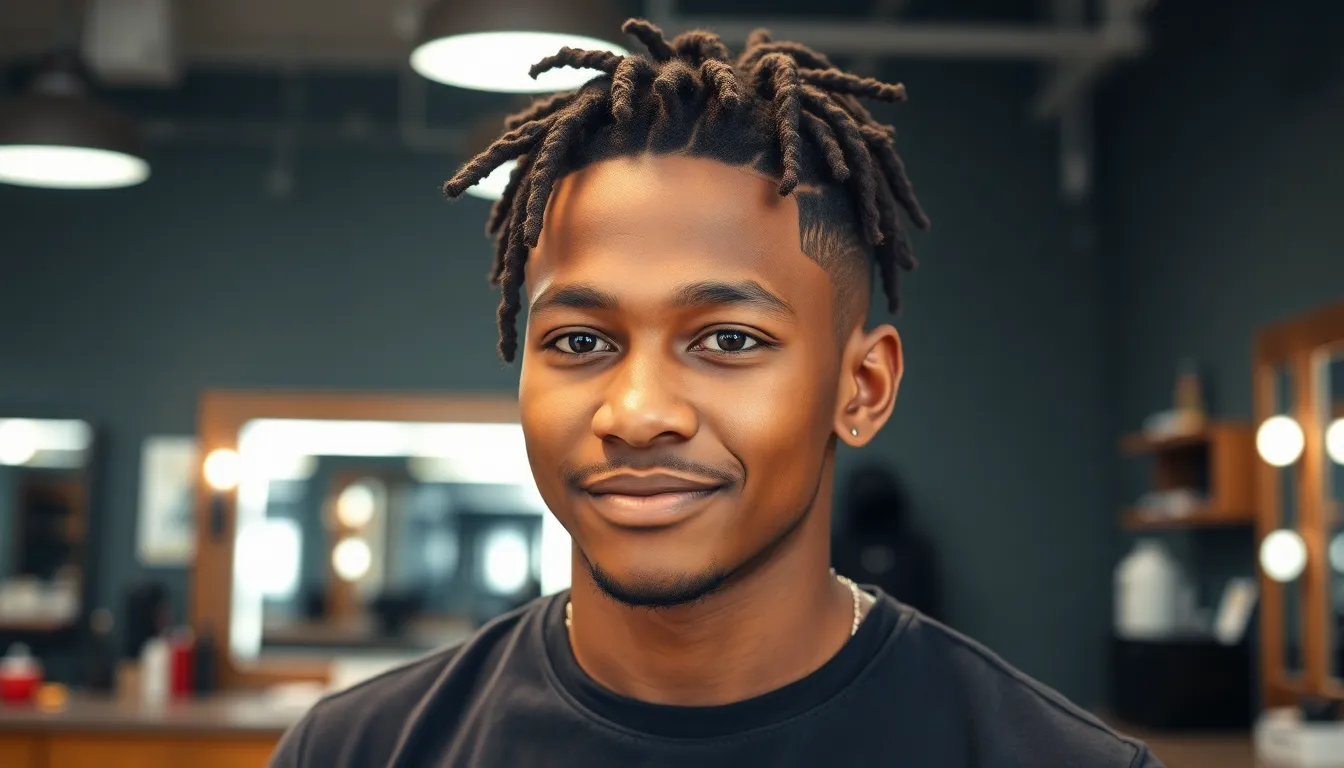
Short dread undercuts represent the perfect fusion of edgy modern barbering with traditional loc styling. We’ve seen this combination become increasingly popular because it creates a bold contrast that makes your dreads the undeniable focal point of your look.
Side-Swept Variations
Side-swept short dreads offer an asymmetrical approach that adds sophisticated flair to your undercut style. We recommend styling your locs to one side while keeping the opposite side tapered or faded for maximum definition. This creates a ever-changing flow that works equally well in professional settings and casual environments.
Versatility makes side-swept variations particularly appealing since you can adjust the sweep angle based on your face shape. Sharp angular sweeps complement round faces while softer curves balance more angular features. Adding subtle texture or slight curls to your swept dreads enhances the overall movement and visual interest.
Maintenance for side-swept styles requires regular palm rolling to maintain the directional flow. We suggest using a light styling gel to keep your locs positioned properly throughout the day without creating buildup or residue.
Disconnected Styles
Disconnected dread undercuts create the most dramatic contrast by emphasizing a sharp separation between your dreads and the surrounding shaved areas. We’ve observed this style gaining traction because it makes a bold fashion statement while remaining surprisingly manageable. The “disconnected” element means there’s no gradual blending between the top and sides.
Sharp contrasts define this look with clean lines that create visual boundaries around your dreads. Adding shaved patterns or designs to the disconnected areas can further personalize your style. Line-up edges become especially important in disconnected styles since they frame the entire look.
Color enhancement works exceptionally well with disconnected styles since the contrast naturally draws attention to your dreads. Ombre effects like honey blonde tips or subtle red highlights can add personality without overwhelming the overall aesthetic.
Edging and Line-Up Details
Precise edging and line-up details transform basic short dread undercuts into polished, professional looking styles. We emphasize these finishing touches because they create clean perimeters that accentuate your facial features and overall hairstyle symmetry. Sharp lines around your hairline and temples give your dreads a neat, intentional appearance.
Professional execution of line-ups requires steady hands and attention to detail. The lines should follow your natural hairline while creating geometric precision around your temples. We recommend visiting an experienced barber every 2 to 3 weeks to maintain crisp edges.
Facial feature enhancement occurs when line-ups are carefully shaped to complement your bone structure. Square line-ups work well for round faces while curved edges soften angular features. The key lies in balancing the sharp contrast of your undercut with lines that enhance rather than compete with your natural features.
Styling tools for maintaining sharp edges include quality clippers with precise guards and finishing razors for ultra-clean lines. We suggest using a clear styling gel along your hairline to keep edges looking fresh between barber visits.
Freeform Short Dreads
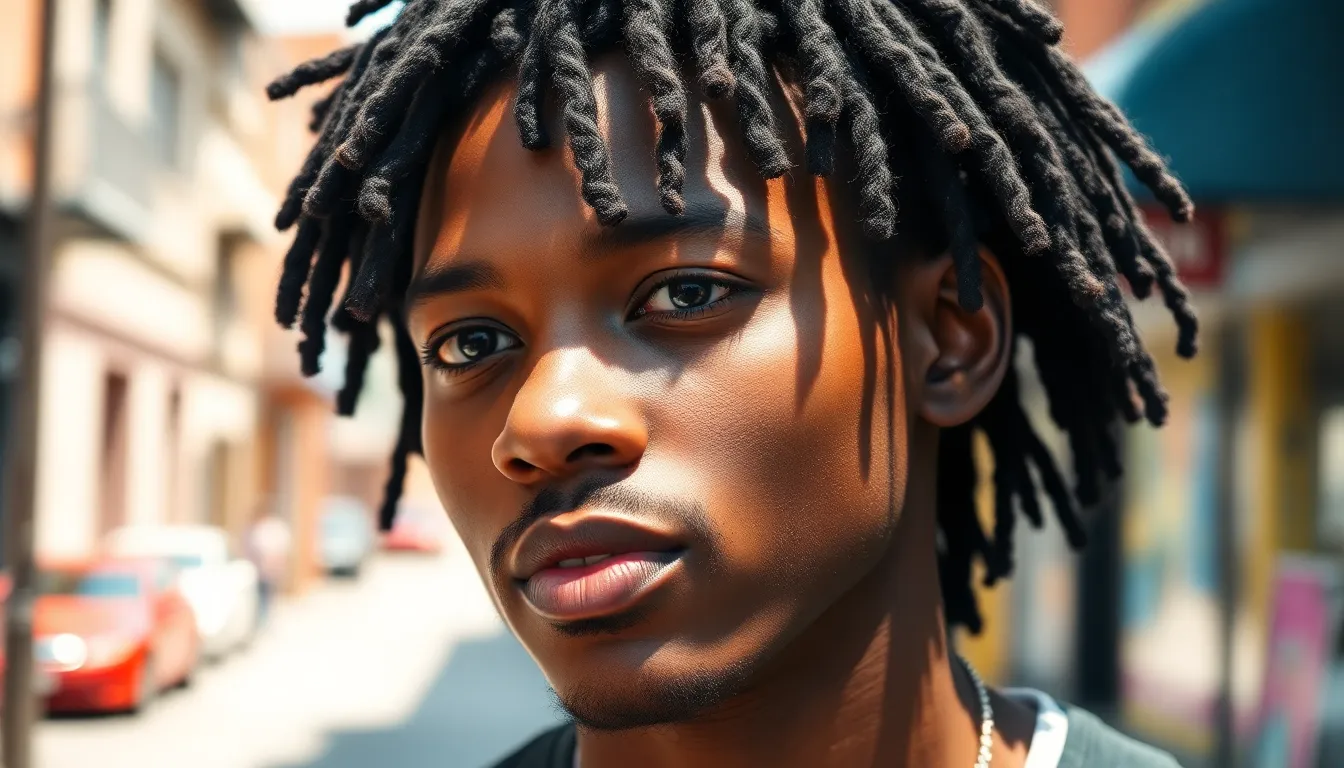
Freeform short dreads represent the most natural approach to loc formation, allowing your hair to develop its unique character without forced manipulation. This method embraces your hair’s natural tangling patterns and individual texture preferences.
Organic Growth Patterns
Natural curl patterns dictate how your freeform short dreads will eventually shape themselves. Your hair’s inherent growth direction determines the placement and thickness of each developing loc, creating an authentically unique look that can’t be replicated. Coarser hair textures typically form more defined sections naturally, while finer hair may create smaller, more delicate locs.
Varied loc sizes emerge organically as your hair follows its natural sectioning preferences. Some areas of your scalp will produce thicker locs while others form thinner ones, reflecting your individual hair density and growth patterns. This natural variation creates visual interest and prevents the uniform appearance of traditionally maintained dreads.
Individual hair texture plays a crucial role in determining your final loc formation. Curly and coily hair types naturally intertwine more readily, leading to faster initial loc development compared to straighter textures. Your hair’s porosity level also affects how quickly moisture moves through each strand, influencing the overall locking timeline.
Minimal Manipulation Approach
Gentle palm rolling becomes your primary maintenance technique for guiding loc formation without forcing unnatural shapes. We recommend using light pressure and rotating motions only when necessary to maintain basic structure. Excessive twisting can stress your hair follicles and create scalp tension that hinders healthy growth.
Occasional sectioning helps prevent locs from growing together while respecting natural boundaries. Your fingers can gently separate any locs that begin merging, but avoid creating artificial parts or forcing uniform spacing. This approach maintains the organic aesthetic while preventing unwanted loc combinations.
Avoiding excessive combing and retwisting preserves your hair’s natural strength and reduces breakage risk. Traditional maintenance methods can weaken hair strands through constant manipulation, while the freeform approach prioritizes hair health over perfect uniformity. Your scalp benefits from reduced stress and maintains better circulation patterns.
Timeline Expectations
Starter locs typically begin forming within 2 to 4 weeks of starting your freeform journey. Initial development appears as loose coils and twists that gradually tighten as your hair naturally tangles. Your hair type significantly influences this early formation period, with coarser textures showing progress more quickly.
Budding stage occurs between 3 to 6 months as your locs develop their characteristic lumpy texture. This phase represents active loc formation where your hair begins creating permanent knots and tangles. We consider this the most crucial period for maintaining minimal manipulation practices.
Mature locs establish themselves after 8 to 18 months depending on your hair’s individual characteristics. Shorter lengths generally mature faster than longer hair due to reduced weight and easier manipulation. Your final loc appearance will reflect months of natural development and your hair’s unique properties.
| Timeline Stage | Duration | Characteristics |
|---|---|---|
| Initial Formation | 2-4 weeks | Loose coils and basic twisting |
| Active Budding | 3-6 months | Lumpy texture development |
| Full Maturation | 8-18 months | Permanent loc structure |
Short Dread Mohawks

Building on traditional loc styles, short dread Mohawks create one of the most striking and contemporary looks available today. This edgy combination merges the rebellious spirit of classic Mohawks with the textured appeal of dreadlocks for a style that’s both bold and surprisingly versatile.
Center Strip Placement
Strategic positioning of your dreadlocks along the scalp’s midline creates the signature Mohawk silhouette we’re all familiar with. The center strip typically runs from your forehead to the crown or nape, forming a narrow or wide band depending on your personal preference and face shape.
Width matters significantly when planning your Mohawk strip placement. A narrower strip of 2 to 3 inches creates a more dramatic contrast with shaved sides, while wider strips of 4 to 5 inches offer more styling versatility for different occasions. Your locs can be styled upright for maximum impact, pulled back for a sleeker appearance, or twisted into intricate patterns that emphasize the strip’s visual appeal.
Face framing becomes effortless with proper center strip placement since the concentrated dreadlocks naturally draw attention upward and create striking visual balance. The contrast between your textured locs and clean shaved sides highlights the Mohawk shape while adding dimension to your overall look.
Side Shaving Techniques
Clean shaves on both sides create the most dramatic contrast with your center strip dreadlocks, delivering that classic Mohawk edge we associate with bold styling choices. This stark approach works particularly well for men with coarser hair textures since the difference between smooth skin and textured locs becomes more pronounced.
Skin fades and taper fades offer a more gradual transition from your dreadlocks to completely shaved areas, creating smooth visual flow that’s both modern and professional. The fade typically starts at a #2 or #3 guard length near your dreads and gradually reduces to skin level, requiring skilled barbering techniques for optimal results.
Design shavings add personalized flair through patterns, lines, or artistic elements cut into the shaved areas surrounding your Mohawk strip. Popular options include geometric patterns, tribal designs, or simple tramlines that complement your locs while expressing individual creativity. These designs require regular touch ups every 2 to 3 weeks to maintain their crisp appearance.
Bold Styling Options
Color enhancement transforms basic short dread Mohawks into eye catching statements that reflect your personality and style preferences. Highlighted dreadlocks using blonde, red, or unconventional colors create vibrant contrast against natural hair tones, while ombré effects gradually transition from darker roots to lighter tips for sophisticated visual interest.
Top knots and tied back arrangements offer styling flexibility for different occasions and settings where you need a more polished appearance. Gathering your Mohawk dreads into a high knot creates a rugged yet refined look that works equally well in professional or casual environments, while pulled back styles elongate your face shape and emphasize your facial features.
Crisscross and patterned dread placements add intricate visual texture to your center strip through strategic loc positioning and interweaving techniques. These arrangements require more initial planning and professional styling but create unique patterns that set your Mohawk apart from conventional approaches.
Artistic fade patterns on the sides complement your dreadlocks through creative barbering that incorporates waves, geometric shapes, or custom designs customized to your preferences. These bold additions require collaboration with experienced barbers who understand both loc maintenance and precision fade work for optimal results.
Colored Short Dreads
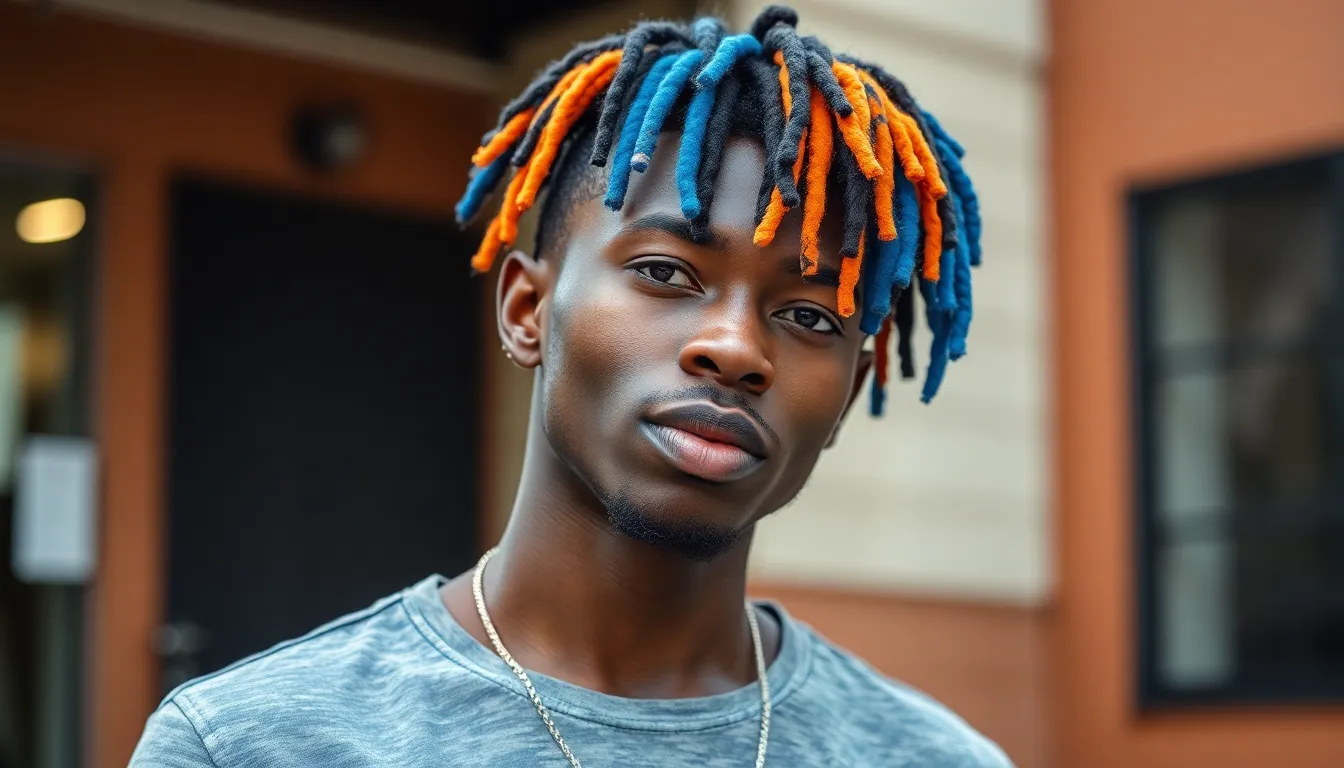
We’ve witnessed a remarkable trend in men’s hair styling where short dreads become canvases for creative color expression. Men with short dreadlocks increasingly experiment with vibrant hues to enhance their distinctive look.
Popular Color Combinations
Ombré effects dominate the short dread color scene, with dark roots transitioning seamlessly to lighter ends like honey blonde, red, or orange. This technique adds visual dimension without requiring complete hair transformation. Black roots paired with blonde or honey tones create the most requested combination at barbershops nationwide.
Natural black bases work exceptionally well with red or burgundy highlights, offering a sophisticated yet bold appearance. These combinations maintain professionalism while expressing individual style. Crimson accents provide striking contrast against darker hair, making each loc pop with personality.
Bright color applications include full coverage options like vibrant orange or electric blue for those seeking maximum impact. These bold choices transform short dreads into statement pieces. Accent coloring on select locs creates visual interest without overwhelming the overall look.
Bleaching Considerations
Bleaching becomes necessary when transitioning from natural black or dark brown hair to lighter shades. Professional bleaching services ensure even color distribution and minimize damage risks. We recommend consulting experienced colorists who understand dreadlock structure before beginning any bleaching process.
Hair shaft weakening occurs during bleaching, making dreads more susceptible to breakage and damage. Shorter locs require extra caution since they’re newer and haven’t fully matured. The bleaching process can compromise loc integrity if not performed correctly.
Conditioning treatments become essential after bleaching to restore hair health and moisture balance. Special care products designed for chemically treated hair help maintain loc structure. Moisturizing routines prevent brittleness and preserve the hair’s natural strength.
Maintenance Challenges
Regular washing with residue free shampoos prevents buildup that can compromise loc formation and color vibrancy. Color treated dreads require specialized products that protect both the loc structure and dye molecules. We recommend washing every 5 to 7 days to maintain cleanliness without over stripping.
Retightening schedules become more frequent with colored short dreads to maintain shape and prevent frizz. Palm rolling every 4 to 6 weeks keeps locs neat and properly formed. Professional maintenance visits ensure consistent results and prevent damage from improper techniques.
Color preservation demands exact care routines including UV protection and gentle handling during styling. Vibrant colors fade faster than natural tones, requiring touch up appointments every 6 to 8 weeks. Quality styling products designed for colored hair extend color life and maintain loc health.
Styling versatility remains possible even though maintenance requirements, with many men pairing colored short dreads with fades or undercuts for modern appeal. Regular barber visits every 2 to 3 weeks maintain clean lines and sharp contrasts. This combination creates striking visual impact while keeping overall maintenance manageable.
Professional Short Dread Styles

We understand that maintaining a professional appearance while expressing personal style can be challenging, but short dread styles offer the perfect balance for modern workplace environments.
Workplace-Appropriate Looks
Short locs with tapered or skin fades create the most polished professional appearance for men in corporate settings. These styles keep the length manageable while reducing bulk, making them comfortable and sophisticated for office environments. We recommend combining short dreadlocks with precise line-ups along the hairline to add modern sophistication while maintaining a conservative silhouette.
Classic short dreadlocks pulled back offer versatility for business meetings and formal settings. Styling them in low ponytails helps frame the face professionally while avoiding any casual or messy appearance. These arrangements work exceptionally well across various industries, from creative fields to more traditional corporate offices.
Chunky or twisted locs provide a fashionable yet neat alternative when styled with precision. Two-strand twists can be maintained to avoid appearing unkempt, granting a sophisticated look that’s appropriate for conservative workplaces. Incorporating undershaves beneath the locs adds a contemporary edge while keeping the overall appearance tidy.
Conservative Styling Methods
Regular maintenance and retwisting ensures the cleanest professional appearance for workplace settings. We suggest scheduling retwisting appointments every 4 to 6 weeks to maintain tighter, cleaner locs without loose hairs that could compromise your professional image.
Minimal coloring approaches respect office norms while allowing personal expression. Natural hues work best in business environments, though subtle highlights can add dimension without being distracting. Avoiding bold colors helps maintain professionalism across all corporate cultures.
Professional updos and crown styles keep locs off the face and neck for formal business environments. Neat loc crowns and strategic pinbacks present a composed look that’s ideal for important meetings and presentations. These styling methods demonstrate attention to detail while maintaining the textured appeal of short dreads.
Business Setting Adaptations
Length management proves crucial for corporate acceptance of dreadlock styles. Short to mid-length locs are preferred in professional environments because they’re easier to manage and maintain a polished appearance throughout the workday. Avoiding overly long or unruly locs helps ensure your style remains appropriate for conservative business settings.
Fade incorporation provides contemporary edge without overstepping formality boundaries. Tapered sides and back sections keep the style modern while preventing any distraction from the business atmosphere. These technical elements help bridge the gap between personal expression and professional expectations.
Cross-industry adaptability makes these styles suitable for various professional sectors. From creative agencies to traditional corporations, well-maintained short dread styles work when styled carefully and kept conservative. Regular upkeep and attention to detail ensure these looks remain appropriate regardless of your exact industry requirements.
Short Dread Accessories

We enhance our short dread styles with carefully chosen accessories that combine functionality with personal expression. These essential elements help maintain structure while adding unique flair to our locs.
Rubber Band Placements
Rubber bands serve as fundamental tools for sectioning and securing our short dreads during the early stages of locking. We typically place them at the roots to maintain shape and prevent unraveling as our locs develop their natural structure. Positioning varies based on our dread size and personal preference, with most placements occurring around the base or tip areas for maximum control.
Strategic placement at the ends helps our starter locs maintain their defined sections while the hair begins its locking journey. We find that rubber bands offer functional benefits by keeping our dreads tight and well defined, making them ideal for short starter locs. These simple accessories also enable us to create versatile styles like ponytails and half updos when we want to switch up our look.
Decorative Elements
Decorative beads transform our short dreads into personalized statements of style and cultural expression. We thread or clip various accessories like cuffs, shells, and rings onto our locs to add both subtle and bold accents that reflect our personality. These elements make our short dreads stand out with unique flair that sets us apart from traditional styling approaches.
Color treatments offer another powerful way to decorate and modernize our short locs without requiring additional length. We incorporate ombré effects and strategic highlights to add depth and visual interest to our hairstyle. These color enhancements create uniqueness while maintaining the manageable nature of shorter dreads, giving us the best of both worlds in terms of style and practicality.
Functional Hair Ties
Hair ties enable us to gather our short dreads into various arrangements like ponytails, buns, and top knots for different occasions. We choose elastic hair ties with smooth finishes to prevent breakage and ensure our locs stay securely in place throughout the day. These accessories provide the mobility and control we need for active lifestyles while maintaining our polished appearance.
Combining functional ties with rubber bands gives us versatile styling options that work across multiple settings from sports activities to formal events. We can easily transition our short dreads from casual daytime looks to professional evening styles using these simple yet effective accessories. This flexibility allows us to maintain neat and stylish appearances while adapting to different social and professional environments throughout our day.
Conclusion
Short dread styles offer the perfect balance between self-expression and practicality for today’s modern man. Whether you’re drawn to classic twisted locs or bold mohawk variations we’ve shown you there’s a style that fits your lifestyle and personality.
The beauty of short dreads lies in their adaptability – they work seamlessly in professional environments while still allowing creative freedom through colors accessories and unique cuts. With proper maintenance and the right technique you can achieve a look that’s both distinctive and manageable.
We encourage you to experiment with different approaches from freeform methods to structured twisting techniques. Remember that patience is key as your locs develop their unique character over time.
Start your short dread journey today and discover how this versatile hairstyle can transform your look while fitting perfectly into your daily routine.
Frequently Asked Questions
What are short dreadlocks and why are they becoming popular?
Short dreadlocks are a modern hairstyle featuring twisted or locked hair sections that are typically 2-4 inches long. They’re gaining popularity because they offer the distinctive texture of traditional dreads with lower maintenance requirements. Short dreads suit all face shapes and lifestyles, making them perfect for busy professionals and creative individuals who want a stylish yet manageable look.
How long does it take for short dreads to form and mature?
Short dreads typically take 3-6 months to fully mature, though this varies by hair texture. The process begins with initial formation in 2-4 weeks, followed by active budding at 3-6 months, and complete maturation between 8-18 months. Coarser hair tends to lock faster than finer textures, and proper maintenance helps ensure healthy development.
What techniques can be used to create short dreadlocks?
Several techniques work for creating short dreads, including the traditional twisted locks method using backcombing and palm rolling, the two-strand twist method for neater texture, and the freeform or neglect method for natural development. Each technique produces different textures and requires specific hair lengths, typically starting with 2-4 inches of hair.
How often do short dreads need maintenance?
Short dreads require minimal maintenance compared to longer styles. Root maintenance should be performed every 4-6 weeks, with light palm rolling to maintain shape. Weekly care includes washing with residue-free shampoo and light moisturizing. Professional touch-ups for fades or undercuts may be needed every 2-3 weeks to keep the style sharp.
Can short dreads be styled professionally for the workplace?
Yes, short dreads can be very workplace-appropriate when properly maintained. Professional styles include short locs with tapered or skin fades, classic short dreadlocks in low ponytails, and conservative styling with minimal coloring. Regular retwisting every 4-6 weeks ensures a clean, polished appearance suitable for corporate environments while maintaining personal expression.
What face shapes work best with short dread styles?
Short dreadlocks are versatile and suit all face shapes. The key is choosing the right variation – high top fades work well for round faces, while taper cuts complement square faces. Short dread undercuts can enhance angular features, and freeform styles adapt naturally to individual facial structure, making them universally flattering.
How do I maintain colored short dreads?
Colored short dreads require specialized care to preserve vibrancy and hair health. Use residue-free shampoos designed for colored hair, maintain regular retwisting schedules, and apply protective treatments. Professional coloring services are recommended to minimize damage, especially when bleaching for lighter shades. Expect increased maintenance compared to natural-colored dreads.
What products should I use for short dread maintenance?
Essential products for short dreads include residue-free shampoos for regular cleansing, lightweight moisturizing sprays to prevent dryness, light styling gels for holding power, and scalp oils for healthy growth. Avoid heavy products that can cause buildup. For styles with fades, use quality edge-up tools to maintain sharp lines.
Can I add accessories to short dreadlocks?
Yes, short dreads can be enhanced with various accessories. Rubber bands help with sectioning during early locking stages, while decorative beads and color treatments add personal flair. Functional hair ties allow for different arrangements and easy transitions between casual and professional looks, making short dreads versatile for any occasion.
What’s the difference between freeform and maintained short dreads?
Freeform short dreads develop naturally with minimal manipulation, allowing individual curl patterns to dictate shape and thickness for an authentic, unique look. Maintained short dreads involve regular palm rolling, sectioning, and styling to create uniform appearance and controlled growth patterns. Freeform requires less intervention but offers less control over final appearance.
